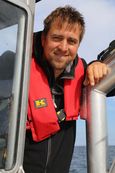Scientific cruise leader:

- Phone
- +49 381 66099 136
- daniel.stepputtis@thuenen.de
Solea, 784th cruise
Duration: October 27 – November 6, 2020
Area: Baltic Sea
Purpose: Fisheries technology
The European Fisheries Policy compels fishermen to land all catches from quoted species. Under the Landing Obligation, fishing activities targeting Baltic flatfish species are being chocked by the limited available quotas for the Western and Eastern Baltic cod. Recently, the European Commission requested advice from ICES on how to avoid limited cod quotas from chocking fisheries targeting other species. Among other solutions, fishing technologist from Denmark (DTU-Aqua), Sweden (SLU) and Germany Thünen Institute) jointly presented a set of bycatch reduction devices to avoid cod catches in flatfish fisheries. The devices proposed were classified based on their basic functioning principle:
- mechanical selectivity devices that take advantage of differences in morphology between cod and flatfish,
- selectivity devices that make use of differences in behaviour between species to sort and exclude cod, and
- selectivity devices which combine the strategy 1) and 2).
A sequence of three sea cruises has been planned to test some of the selection concepts proposed. The two first cruises (Clupea 340, December 2019, and Solea 773, February 2020) were used to test behavioural selection devices related to functioning principle (2). A third cruise (Solea 775) was planned for March 2020 to investigate how to avoid cod bycatches by taking advantage of differences in morphology between cod and flatfish) by innovative codend designs. This cruise had to be cancelled due to the Covid19-pandemic. Therefore, some of the planned experiments shall be conducted during this cruise. It is aimed to intensively use underwater cameras to gain insights in the behaviour of fish and net.
In addition to these experiments, it is planned to investigate the physical performance of selected net configurations used in the North Sea brown shrimp fishery (Crangon crangon). The investigations will be carried out using underwater cameras and sensors.




